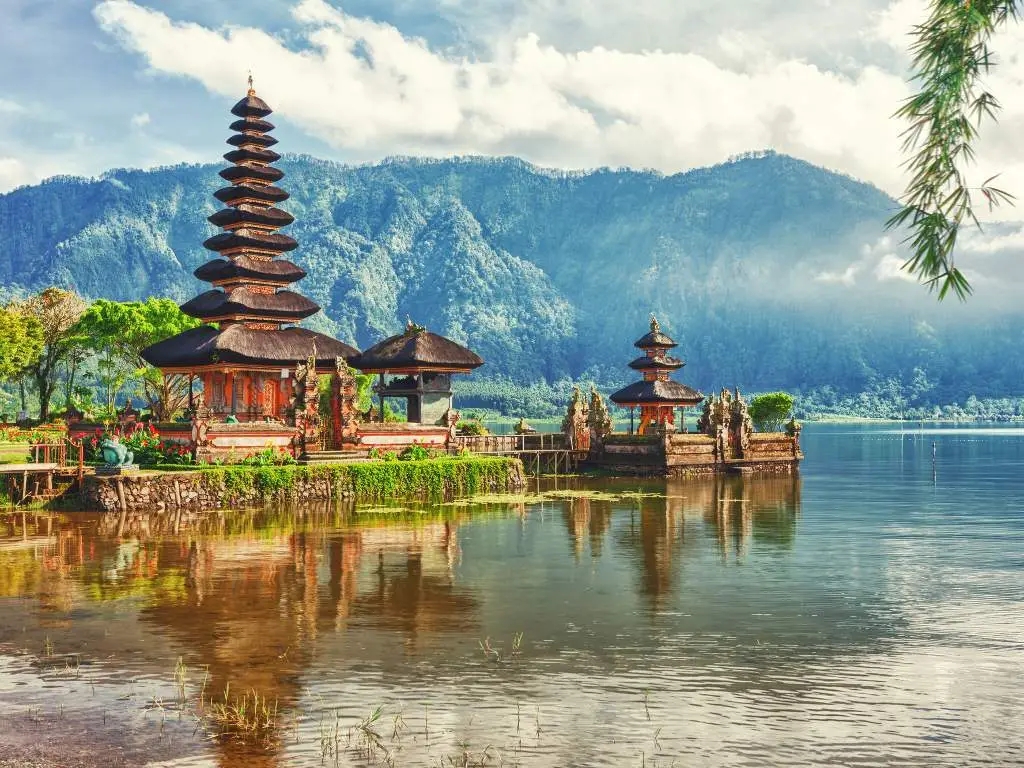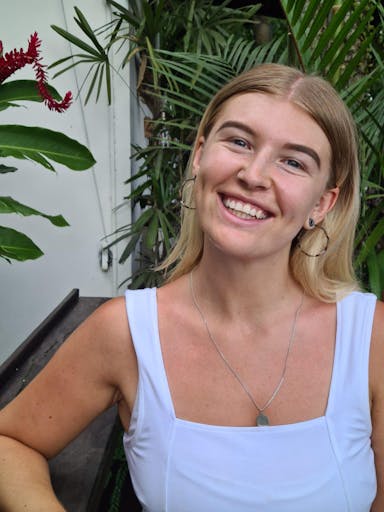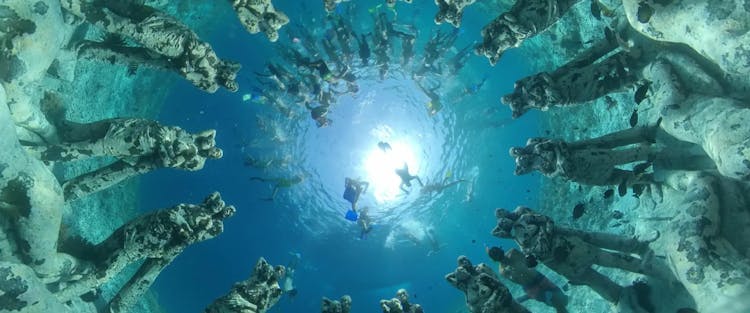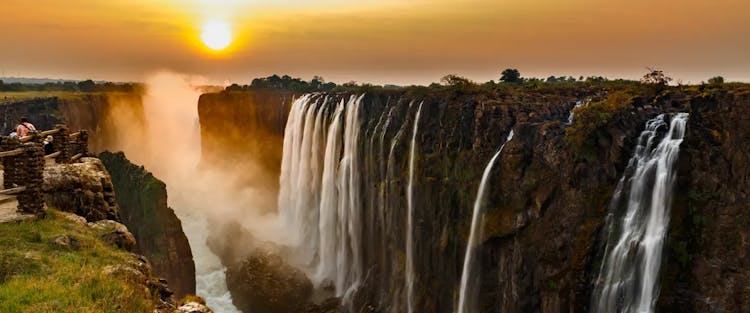
Bali: The Indonesian Island Home to Part of the Most Biodiverse Reef in the World
Of Indonesia's 17,000 tropical islands, Bali is one of the most famous. Its four million residents come accompanied with more than six million tourists per year as well as a large population of monkeys, dolphins, and awe-inspiring marine life all set on and around an island just a bit larger than Delaware.
With its spectacular mountainous backdrops, idyllic sunsets, tranquil Hindu temples, and chili-laced street food, it's easy to fall in love with Bali.
An island of beaches, jungles, waterfalls, and active volcanoes

At 2,232 square miles, Bali is Indonesia’s 15th-largest island. It takes around 12 hours to drive the perimeter of the island and in that time, you'll come across dense jungles and rainforests, three volcanic peaks, mesmerizing waterfalls dropping into glass-like lakes, and turquoise waters.
That diverse terrain means activities include everything from sunrise hikes up Mount Batur, an active volcano, to coffee in cafes above the clouds in Kintamani, a village on the edge of the Mount Batur caldera, to endless days spent soaking up the sunshine on Uluwatu’s gorgeous beaches at the southern tip of the island.
50 shades of sand

There are upwards of 20 beaches around Bali with nearly a rainbow’s worth of colors throughout. There’s white sand and freshly picked coconuts in honeymoon-heaven Nusa Dua on the island’s southern tip. Check out black sand and pods of dolphins in Lovina, a laid-back resort town in the north. Or opt for golden sand and surf trips in Kuta or Seminyak, two of the most popular tourist-heavy towns in the south. Uluwatu’s Melasti beach, at the southernmost point of the island, is one of the finest, or head to Bias Tugel beach on the east coast for stunning clear blue waters.
And, if you're looking for something extra special, head over to neighboring islands Lombok or Komodo for pink sand beaches. Bali's black sand was formed when lava erupted from the island's volcanoes, while the pink sand originates from foraminifera—tiny red organisms that live in coral reefs and get washed up on the beach.
Marine life of every shape, color, and size

Bali’s islands are part of the Coral Triangle, a marine region that spans parts of Indonesia and neighboring countries and is the planet's richest center of underwater life and coral diversity, home to nearly 600 reef-building coral species (about nine times the amount found in the Caribbean). These islands boast some of the world's most impressive marine creatures, ranging from the 14-foot mola-mola (also known as the ocean sunfish) to dolphins, turtles, and sharks.
Both mainland Bali and its nearby Nusa islands are home to incredible snorkeling and scuba diving sites with dazzling coral reefs and spectacular underwater topography. If you're looking to get a little more off the beaten track, head up to the northwest coast to find Menjangan Island. Bali's first internationally known diving location, it rose to fame after the Indonesian Navy organized a get together of the country’s main diving clubs back in 1978.
The land of a thousand temples (and a few more)

Walk through the streets of Bali and you'll spot small banana leaf packages on the floor adorned with flowers and incense. Called Canang sari, these are daily offerings left out to symbolize gratitude to Hindu’s Supreme God.
Indonesia is home to the world’s largest Muslim population, but Bali is the only place in Indonesia with a majority Hindu population, with roughly 86% of people practicing.
It's estimated there are more than 10,000 temples here and spirituality features in almost every decision. Before officially building a house or opening a new business, the Balinese traditionally hold a blessing ceremony, called melaspas, which is organized around the Balinese saka calendar. Visitors can also experience their own blessing ceremony at places like Tirta Empul, Bali’s sacred water temple. Here, you'll be guided through a purification ritual involving chants, meditation, prayer, and a bath in the holy water.
An annual festival with 24 hours of silence
Nyepi is the most culturally significant day in Bali, marking the turn of the New Year in the Balinese saka calendar. It typically falls in March or April and is known as the "day of silence,” as it is a time of purification and compulsory quietness.
The night before, huge homemade statues called Ogoh-ogoh are paraded through the streets to bewilder the evil spirits that will fly across Bali. It's also a time to connect with God and express gratitude, cleanse the island’s misdoings, and ensure a positive year ahead. On this day, there is a 24-hour lockdown where lights and electricity are turned off, everyone stays home, and even the international airport closes.
Yoga retreats around every corner
Yoga is one of the six teachings in Hindu philosophy and a big part of daily life in Bali. The practice of yoga in Indonesia dates back to around 109 AD. From the 1990s, its popularity began to develop at a faster pace with opportunities run mostly by locals but also gurus from India (yoga’s birthplace) and the wider world.
Today, this spiritual island is well-deserving of its world-famous yoga reputation, with an estimated 450+ retreats happening each year. Ubud’s peaceful jungles are widely known as the island's yoga capital and you'll find all kinds including Hatha, Vinyasa, and Ashtanga at the likes of The Yoga Barn and Intuitive Flow.
Tastebuds at the ready

The Balinese have grown white, black, and red rice (or "nasi" in Bahasa Indonesia) for thousands of years and it makes up the basis of many meals. Warungs are the best places to sample the—these small, family-run restaurants offer an ever-changing assortment of dishes. You'll also spot street vendors weaving their colorful "kitchen carts" between traffic lanes, serving up bakso (meatballs) or mie (noodles).
Typically served with an assortment of meat, vegetables, and a spicy chili-based sauce called sambal, Balinese food is influenced by the island's natural resources, the Hindu religion, and cultural habits passed down through generations. Herbs and spices play a big role here, like in Basa gede, a spice paste including shallots, garlic, turmeric, and ginger, which makes up the basis of many meals. Or try Bali's most famed dish, Babi Guling, a whole pig roasted with herbs and spices traditionally served with sticky rice and peanuts.
The world’s most expensive coffee comes partially digested

Kopi luwak coffee (sometimes known as civet coffee) typically costs between $35 and $100 per cup and is made from partially digested coffee cherries eaten and defected by the cat-like Asian palm civet. Supposedly, their digestive juices ensure a smoother cup of coffee compared to your regular, non-defecated cup.
The coffee originated in neighboring Java during the Dutch colonial period in the 17th century, when Indonesian coffee farmers were forbidden from picking their own fruit and used the processed cherries out of desperation. While it’s mostly produced on the larger islands of Sumatra and Java, it's popular across Bali, too (usually with tourists) thanks to its rich, heavy, subtly sweet flavors. If you're looking to try it, ensure you're drinking coffee that has Rainforest Alliance certification.
Good to Know
Is Bali expensive?
Bali is a pretty inexpensive destination. With a huge selection of mid-range hotels to choose from, the average double-occupancy room may only be $30-60 per night. There are more luxury hotels if you’d like to splurge, of course, as well as even cheaper rooms for travelers on tighter budgets. You can get a great meal of local food in Bali for less than $5 per meal (international cuisine tends to be closer to $8 per meal).
Best time to visit Bali
Bali’s dry season, from April-October, offers the most pleasant weather. The temperature stays fairly consistent year-round, but the rainfall and humidity levels are lowest from April-October.
What languages are spoken in Bali?
Bahasa Indonesia and Balinese are the official languages of Bali, though you’ll find English is fairly well-understood—especially in the tourist-centric parts of the island down south. English is less prevalent elsewhere on the island.
Bali with kids
The southern part of Bali is quite family-friendly, as you’d hope any destination with beaches would be. In addition to the fantastic beaches and many water sports kids can enjoy, Bali also has lush jungles, fascinating temples, colorful markets, and wildlife experiences.
Keep in mind, though, that parts of the island that don’t cater so much to tourists (the middle and northern parts) are a bit less family-friendly.
Bali public transportation
Public transportation options in Bali aren’t great. There are some inexpensive public buses, but they’re not very efficient and may be confusing to visitors.
Taxis are plentiful, but they have a bad reputation for scamming tourists. Using rideshare apps (like Grab or Gojek) is a much safer bet. Bike taxis are a cheap option, at about 50 cents for a short trip, and cars typically start at about $3. If you’re venturing away from the more populated areas, where rideshare services aren’t an option, you can hire a private car and driver .
Is Bali safe?
Bali ranks #47 out of 163 countries on the Global Peace Index.
Bali ranks #121 on the LGBTQ+ Equality Index.
Getting to Bali
- Main airport: DPS
- Average Going price for cheap flights to Bali: $588
Going members get amazingly cheap flights delivered right to their inboxes.
More Asia destinations:
Published October 24, 2023
Last updated December 19, 2023
Articles you might like
View AllTreat your travel to cheap flights
Most deals are 40-90% off normal prices with great itineraries from the best airlines. If it's not an amazing deal, we won't send it. Sign up for free to start getting flight alerts.




